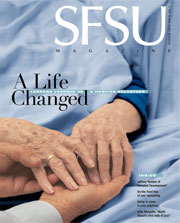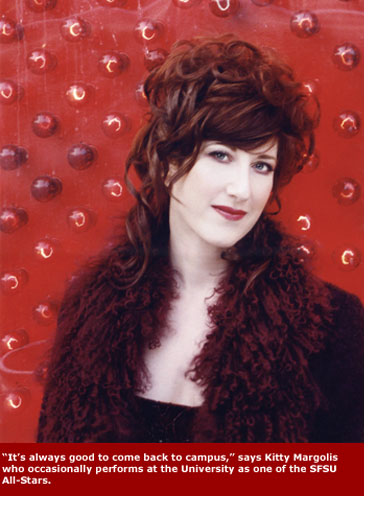 |
| |||
"It was one of those huge 'a-ha!' moments," says renowned jazz vocalist Kitty Margolis, about the night her uncle took her to see saxophonist Rahsaan Roland Kirk at the Village Vanguard in New York City. "I saw a wonderful older gentleman in dark glasses, a wild hat and three saxophones in his mouth making the most amazing, otherworldly sounds," she recalls. "It was a spiritual experience." It was the late 1970s and Margolis, then a student at Harvard University, had been singing with a western swing band in the evenings and excelling in her coursework in visual and environmental studies. After her "first real jazz concert," she says, "my life was never the same." Margolis grew determined to become a jazz singer and to learn the art of recording. After hearing high praise for both broadcasting and jazz at San Francisco State's College of Creative Arts, she decided it was the right place to meet both objectives. The sophomore left Harvard and enrolled in classes at SFSU in 1977. Margolis has since sung at legendary jazz clubs and festivals on four continents and performed and recorded with such notables as Elvin Jones, Red Holloway, David "Fathead" Newman, and Lionel Hampton, who dubbed Margolis "the next great jazz voice." At the heart of her work is improvisation. "My songs are never sung the same way twice," she says, pointing out that the Latin word "improvisus" means unforeseen. The New York Times and Village Voice jazz critic Will Friedwald regards Margolis as one of today's keepers of the scat tradition -- the art of using sounds and syllables to improvise a melody. He points to the greats: Ella Fitzgerald, Sarah Vaughan, Mel Torme, Mark Murphy, Anita O'Day and the late Betty Carter and calls Margolis "the direct heir to their legacy." Sitting in the window of a North Beach café and looking out at the neighborhood she has called home most of her adult life, the singer says she couldn't have grown up at a better time in San Francisco: "I was barely 12, but I would go to the Fillmore Her latest album, "Heart and Soul: Live in San Francisco," was recorded in a theater a few blocks away, not far from both the headquarters of her independent record label, Mad-Kat Records, and the home she shares with her husband, Alfonso Montuori, a professor at the California Institute of Integral Studies and her producer. Margolis says what she absorbed at SFSU was invaluable. She learned recording studio microphone techniques and how to operate the mixing board and run a good sound check. She also took advantage of classes led by such renowned, professional jazz musicians as sax player and composer John Handy, who taught jazz history at the time. He came to admire Margolis's depth of musical knowledge and her approach to singing. Though Handy doesn't often play with singers, he has since performed on campus with Margolis as well as other former and current music faculty known as the SFSU All-Stars. "Kitty takes chances," Handy says, "the kind of artistic risks most singers would not even know were there, let alone dare to take." Margolis remembers one class in particular that was difficult to get into, but well worth the trouble. She had to plead with Hal Stein for a seat in his jazz improvisation class. At the time, the veteran sax player had yet to admit a vocalist to the class -- or a woman. "When he finally agreed to admit me," Margolis recalls, "he told me, 'I'm not going to treat you any differently.'" In the end, Stein asked his student to take over his long-standing Saturday night gig at Peta's, a North Beach institution. The regular gig launched Margolis's professional career and in 1978 she left SFSU to begin touring. Her performances came to a halt, however, in the late 1980s when a back problem left Margolis bedridden. "I had weeks to meditate. ⦠I vowed that if I got better I'd have a record out within a year," she recalls. "But I didn't want to wait around for a record deal." So Margolis put what she had learned in the College of Creative Arts toward her debut release, "Live at the Jazz Workshop." "There were virtually no artist-run indie jazz labels at that time," she remembers. "We were working on blind faith and a burning desire to call our own creative shots." As CEO of Mad-Kat, Margolis continues to enjoy having complete artistic control of her recordings. She also enjoys giving private lessons to aspiring singers. When students ask, "How do I sing this song?" she warns them not to study other singers' renditions. Instead, Margolis encourages them to learn the lyrics, melody and chords just the way they were written. "You've got to really know the bones of a tune," she says, before beginning the musical deconstruction and reconstruction that defines jazz. Scat aside, Margolis insists that "telling the story and making people feel something is the ultimate goal in singing." It's a goal she achieved long ago. "There is nothing like the circle of energy between the band and the audience on a good night," she says. "When it's happening, it's the best feeling in the world." | ||||










